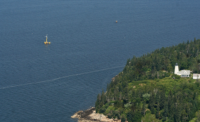In early June, the University of Maine will launch a small-scale offshore demonstrator of a floating wind turbine, fabricated in its lab with a lightweight concrete foundation and composite tower. If successfully connected to the grid from off the coast of Castine, Maine, it will be the first of its kind in North America.
The approximately 65-ft-tall turbine prototype is built to one-eighth the scale of a 6-MW turbine with a 423-ft-dia rotor.
“Each blade [of the full-scale design] is larger than the wingspan of the Boeing 747-400,” said Habib Dagher, director of the Advanced Structures and Composites Center (ASCC) at the University of Maine, Orono, at the unveiling of the hull on May 8.
The full-size, semisubmersible unit, scheduled to connect to the grid in 2016, will float in 250-ft-deep waters and rise 600 ft—45 ft taller than the Washington Monument.
“This is the first offshore floating wind turbine in the world with a concrete substructure and a composite tower,” said Dagher, who for the past five years has headed up the research and development conducted by the DeepCwind Consortium. Led by the University of Maine, DeepCwind is a public-private research program that is publicly funded by the U.S. Dept. of Energy, the National Science Foundation’s Partners for Innovation program and the state of Maine, which is showing its support through the Maine Technology Institute and the University of Maine. On the private side, there are more than 30 industry partners.
According to the U.S. Energy Information Administration, Mainers pay 11.94 cents per 4 kilowatt/hours of electricity, 24% above the U.S. average. The program's goal is to cut the cost of offshore wind power to 10 cents per 1 kilowatt/hour, which would be competitive with other forms of electricity generation that are not subsidized, Dagher says. This goal is technically feasible by 2020, when the wind farm is slated to reach commercial scale, Dagher asserts. “The challenge is to compete with natural gas by 2020,” he says.
By 2030, Maine plans to deploy 5 GW of offshore wind. State officials claim the initiative could attract up to $20 billion in private investment. In deep water within 50 miles offshore, the researchers have identified 156 GW of untapped offshore wind capacity.
Triple-Hulled Frame
The lightweight-concrete hull was designed by university engineers and constructed at the university lab with the help of industrial contractor Cianbro, Pittsfield, Maine. The trimaran features three radial columns that stand 120° apart from each other and provide buoyancy for the hollow hull, Dagher said. It is painted with three layers of anti-fouling paint—yellow above and red below the waterline. The 65-ft-tall advanced-composite tower required specialized joints and fabrication methods, Dagher said. Before the launch, it will be inserted into the center of the hull, with the turbine resting on top. It now stands outside the university's offshore-wind lab.
The demonstrator hull required specialized concrete-mix designs for the very thin wall structures needed to fit the steel reinforcement, Dagher said. “Tolerances were very stringent: A rebar mat position had to be adjusted if it was one-eighth of an inch out of spec, and [hull] components had to be match-cast to achieve the tolerances needed,” he said.
Cianbro Chairman Pete Vigue says the project used a proprietary lightweight-concrete mix, supplied by Owen J. Folsom Inc., Old Town, Maine. “Typically, the weight of concrete can range from 144 pounds to 150 pounds per cubic foot,” he said. “We wanted [the weight] below 110 pounds per cubic foot.” Due to strength requirements, the team conducted significant testing long before pouring the concrete, Vigue said. He declined to share design specifics because the technology’s patent is pending.








